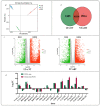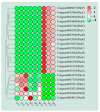Transcriptome Analysis Revealed the Advantages of Room Temperature Preservation of Concentrated Oocystis borgei Cultures for Use in Aquaculture
- PMID: 38003417
- PMCID: PMC10671278
- DOI: 10.3390/ijms242216225
Transcriptome Analysis Revealed the Advantages of Room Temperature Preservation of Concentrated Oocystis borgei Cultures for Use in Aquaculture
Abstract
Oocystis borgei, a microalgae species employed for regulating the quality of aquaculture water, demonstrates the capacity to adsorb noxious substances, curtail the growth of detrimental bacteria, and outcompete blooming cyanobacteria. It can be concentrated by natural sedimentation and stored at room temperature, making it costless and simple to transport and use. To study the mechanism of adaptation to room temperature preservation, O. borgei was concentrated (1.19 × 107-1.21 × 107 cell/mL) and stored for 50 days at low (5 °C, LT), normal (25 °C, NT), and high (35 °C, HT) temperatures, respectively. Polysaccharide content, lipid content, cell survival, and resuscitation were evaluated. RNA-Seq was also used to examine how concentrated O. borgei responded to temperature. During storage, there was an increase in polysaccharide content and a decrease in lipid content, with both being significantly upregulated in the LT and HT groups. Survival and cell density were highest in the NT group. The RNA-Seq analysis revealed extensive differences in transcript levels. ATP synthesis was inhibited in the LT group due to the reduced expression of PsaD, PsaE, PsaF, PsaK, and PsaL. Under HT, the formation of reactive oxygen species (ROS) was facilitated by low levels of redox-related genes (nirA) and high levels of oxidative genes (gdhA, glna, and glts). The findings suggest that storing concentrated O. borgei at room temperature is optimal for microalgae preservation, enhancing theoretical research in this field. Our study provides further theoretical and practical support for the development of O. borgei as a live ecological preparation for aquaculture microalgae ecology management.
Keywords: Oocystis borgei; RNA-Seq; photosynthesis; polysaccharides; room temperature preservation.
Conflict of interest statement
The authors declare that the research was conducted in the absence of any commercial or financial relationships that could be construed as a potential conflict of interest.
Figures






Similar articles
-
Uptake of Urea Nitrogen by Oocystis borgei in Prawn (Litopenaeus vannamei) Aquaculture Ponds.Bull Environ Contam Toxicol. 2018 Nov;101(5):586-591. doi: 10.1007/s00128-018-2450-1. Epub 2018 Sep 28. Bull Environ Contam Toxicol. 2018. PMID: 30267105
-
Allelopathic effect of Oocystis borgei culture on Microcystis aeruginosa.Environ Technol. 2022 Apr;43(11):1662-1671. doi: 10.1080/09593330.2020.1847202. Epub 2020 Nov 26. Environ Technol. 2022. PMID: 33151809
-
Effects of environmental factors on the uptake rates of dissolved nitrogen by a salt-water green alga (Oocystis borgei Snow).Bull Environ Contam Toxicol. 2012 Oct;89(4):905-9. doi: 10.1007/s00128-012-0767-8. Epub 2012 Aug 30. Bull Environ Contam Toxicol. 2012. PMID: 22933173
-
Microalgal Aquafeeds As Part of a Circular Bioeconomy.Trends Plant Sci. 2019 Oct;24(10):959-970. doi: 10.1016/j.tplants.2019.06.005. Epub 2019 Jul 5. Trends Plant Sci. 2019. PMID: 31285128 Review.
-
Advances in microalgal cell wall polysaccharides: a review focused on structure, production, and biological application.Crit Rev Biotechnol. 2022 Jun;42(4):562-577. doi: 10.1080/07388551.2021.1941750. Epub 2021 Jul 28. Crit Rev Biotechnol. 2022. PMID: 34320897 Review.
Cited by
-
Effects and mechanisms of phytohormones in enhancing the resistance of Oocystis borgei to high ammonium nitrogen stress.Sci Rep. 2025 Jul 9;15(1):24604. doi: 10.1038/s41598-025-10398-z. Sci Rep. 2025. PMID: 40634668 Free PMC article.
References
-
- Han P., Lu Q., Fan L., Zhou W. A review on the use of microalgae for sustainable aquaculture. Appl. Sci. 2019;9:2377. doi: 10.3390/app9112377. - DOI
-
- Chang Z., Neori A., He Y., Li J., Qiao L., Preston S.I., Liu P., Li J. Development and current state of seawater shrimp farming, with an emphasis on integrated multi-trophic pond aquaculture farms, in China—A Review. Rev. Aquac. 2020;12:2544–2558. doi: 10.1111/raq.12457. - DOI
-
- Patil P.K., Geetha R., Ravisankar T., Avunje S., Solanki H.G., Abraham T.J., Vinoth S.P., Jithendran K.P., Alavandi S.V., Vijayan K.K. Economic loss due to diseases in indian shrimp farming with special reference to Enterocytozoon Hepatopenaei (EHP) and White Spot Syndrome Virus (WSSV) Aquaculture. 2021;533:736231. doi: 10.1016/j.aquaculture.2020.736231. - DOI
-
- Mohsen M., Lin C., Hamouda H.I., Al-Zayat A.M., Yang H. Plastic-associated microbial communities in aquaculture areas. Front. Mar. Sci. 2022;9:895611. doi: 10.3389/fmars.2022.895611. - DOI
MeSH terms
Substances
Grants and funding
LinkOut - more resources
Full Text Sources
Research Materials

